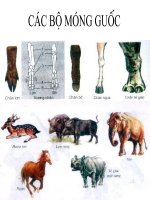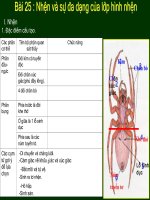Tải Giáo án tiếng Anh lớp 9 Tuần 29 sách mới - Giáo án điện tử môn tiếng Anh 9 theo tuần
Bạn đang xem bản rút gọn của tài liệu. Xem và tải ngay bản đầy đủ của tài liệu tại đây (1.71 MB, 7 trang )
<span class='text_page_counter'>(1)</span><div class='page_container' data-page=1>
<b>GIÁO ÁN TIẾNG ANH LỚP 9 </b>
<b> TUẦN 29</b>
<b>NĂM HỌC 2019 - 2020</b>
<b>Period: 28 Week: 29</b>
<b>Unit 10: SPACE TRAVEL</b>
<i><b>Lesson 3 - A CLOSER LOOK 2</b></i>
<b>I. OBJECTIVES: By the end of this Unit, students will be able to:</b>
Use Past simple and past perfect correctly with confidence
Use defining relative clauses correctly and appropriately
<b>II . PREPARATION: sub -board, pictures, cassette </b>
<b>III. PROCEDURES: </b>
<b>Teacher’s and students’ activities</b> <b>Content</b>
<b>Grammar</b>
<b>Past simple & past perfect: review</b>
Ask Ss to study the timeline to familiarise
themselves with the events and when they happened.
T can read out any two of the events on the timeline,
and ask Ss which event happened first.
<b>Vocabulary</b>
<b>Activity 1: </b>
1 Remind Ss of how to use the past simple and past
perfect.
Have Ss then work individually to complete the
exercise. Tell Ss to pay attention to the position of
already in the sentences.
<b>Activity 2:</b>
Ask Ss to complete the box with T’s year of birth
and their own year of birth. Then ask Ss to check
where the dates fit into the timeline. Ss can write
out the dates and events from the timeline along a
line drawn on a piece of paper. They can then add in
<b>Activity 1: </b>
Key:
1. had been sent; made
2. became; had (already) been
launched
3. had own; walked
4. put; had (already) sent
</div>
<span class='text_page_counter'>(2)</span><div class='page_container' data-page=2>
this task four additional dates.
Have Ss now work in pairs to talk about these
events. Remind them to use the word already. Walk
around the class and provide help if necessary. Call
on some pairs to give their questions and answers in
front of the class.
<i><b>Defining relative clauses</b></i>
<b>Activity 3:</b>
- Draw Ss’ attention to the grammar box and Look
out! box. Give more examples if necessary. Ensure
Ss have understood the rules before moving on.
Have Ss work individually to complete the exercise
and then compare their answers with a partner.
Remind Ss that a relative pronoun may not be
required to complete the sentences (indicated in the
key with a cross).
<b>Activity 4:</b>
- Have Ss work individually to complete the
exercise and then compare their sentences with a
partner.
Remind Ss that a relative pronoun may not be
required to complete the sentences – this is
indicated in the key with a cross (x).
<b>Activity 3:</b>
Key:
1. who/that
2. where
3. which/that/x
4. which/that
5. which/that/ x
6. when
Key:
1. The film which/that/x the class
watched yesterday was about the
Apollo 13 space mission.
</div>
<span class='text_page_counter'>(3)</span><div class='page_container' data-page=3>
<b>Activity 5:</b>
- This activity can be done as pair work or a game
between two big groups. One student or group
describes
the object/person/event using defining clauses for
the other student or group to guess.
3. This is the man who works for
NASA.
4. The team who/that plays on the
left has never won the
championship.
5. The ground-breaking space
mission which/that/x this article
describes is called Rosetta.
6. The task which/that/x the Rosetta
mission has is comparable to a fly
trying to land on a speeding bullet.
<b>IV- HOMEWORK:</b>
-Write new words then learn them by heart.
-Copy the exercise into notebooks.
-Prepare COMMUNICATION
<b>Period: 29 Week: 29</b>
<b>Unit 10: SPACE TRAVEL</b>
<i><b>Lesson 4 - COMMUNICATION</b></i>
<b>I. OBJECTIVES: By the end of this Unit, students will be able to:</b>
talk about space travel history and life on a space station
<b>II . PREPARATION: sub -board, pictures, cassette </b>
<b>III. PROCEDURES: </b>
<b>Teacher’s and students’ activities</b> <b>Content</b>
<b>Activity 1: </b>
-Ask Ss to work in pairs to complete the exercise
after they have looked at the pictures (taking a
shower, sleeping in a sleeping bag, listening to
music, pouring salt).
Accept all answers from Ss and remember to ask
them to explain their decisions. Do not give
</div>
<span class='text_page_counter'>(4)</span><div class='page_container' data-page=4>
corrective feedback at this point.
Now ask Ss to read the text. Tell them to pay special
attention to any information that helps them to
check
their earlier answers. Tell them to notice any new
words as well.
Now give correction.
<b>Activity 2:</b>
Have Ss work individually and then in pairs for this
task.
<b>-</b> After Ss have finished, ask them to study the three
photos of the 155 in the textbook and connect these
photos with the information in the text.
If time allows, T may provide some of the latest
photos and blog posts produced by astronauts who
are living aboard the ISS They are available at
WWW.blog.nasa.gov.
Now ask Ss to come back to the question list which
has been created earlier on the board and try to
answer them with the information from this lesson.
If there are some questions that cannot be answered
with the text, encourage Ss to find more about them
by themselves (using the Internet, books, etc.). T
may provide the NASA blog URL above as an
additional resource.
<b>Activity 3:</b>
</div>
<span class='text_page_counter'>(5)</span><div class='page_container' data-page=5>
This activity can be organised as a debate. Have Ss
work in small groups and agree on the three items
they
will bring to the ISS for each need in 2 . When all
groups are ready with their list, the class gets
together and decides on a new three-item list. Each
group has to persuade the others that their items
should be on this list, rather than those of the other
groups.
<b>Activity 4:</b>
Have Ss work individually and write down a
personal thing they will take aboard the ISS because
they cannot live without it. Then ask Ss to work in
pairs to share what they have written. Ss need to
explain to their partner why this item is so important
to them.
<i>Astronaut Scott Kelly posted this </i>
<i>photo taken from the ISS to Twitter </i>
<i>on Sept. 5, 2015. Credits: NASA.</i>
<b>IV- HOMEWORK:</b>
-Write new words then learn them by heart.
-Copy the exercise into notebooks.
-Prepare SKILLS 1
<b>Period: 30 Week: 29</b>
<b>Unit 10: SPACE TRAVEL</b>
<i><b>Lesson 1 - SKILLS 1 </b></i>
<b>I. OBJECTIVES: By the end of this Unit, students will be able to:</b>
read for specific information about two famous astronauts' space travel
talk about space travel history and life on a space station
</div>
<span class='text_page_counter'>(6)</span><div class='page_container' data-page=6>
<b>III. PROCEDURES: </b>
<b>Teacher’s and students’ activities</b> <b>Content</b>
<b>Activity 1: </b>
-Have Ss work in pairs. Ask Ss to focus on the
photos and try identifying the Vietnamese astronaut
(Pham Tuan). Ask if they know anything about
Pham Tuan. Pairs can share what they already know
about Pham Tuan. After that, have Ss turn the page
upside down and read the Quick facts box, then they
tell each other some more information about Pham
Tuan in full sentences.
<b>Activity 2:</b>
a/ Explain to Ss they are going to read a text about
two famous astronauts talking about their space
travel experience. Ask Ss to guess what they think
the two astronauts will talk about. T may refer back
to the information about the ISS that Ss have learnt
about in COMMUNICATION.
Have Ss then read the text and do the exercise
individually. Discuss the answers with the class but
remember to ask Ss to explain their decisions. (Why
do you think this quote should go in this
paragraph?)
<b>b/ Have Ss work in pairs to complete the exercise.</b>
When giving feedback, ask Ss to give further
information in the text to back up their answers.
<b>Speaking</b>
<b>Activity 3:</b>
-3 Have Ss work in pairs for this task to discuss the
Key:
1. c
2. a
3. b
Key:
1. Pham Tuan is Viet Nam's first
astronaut, and Christer Fuglesang is
Sweden's first astronaut.
2. He found that the Earth didn't
look as big as he thought, and he
thought we should cooperate to take
care of it.
3. It seemed he didn't enjoy it much
since it wasn't fresh.
4. They talked to him when he was
in space and that made him happy.
5. They think the chance to fly into
space is equal for everyone.
</div>
<span class='text_page_counter'>(7)</span><div class='page_container' data-page=7>
qualities and skills.
First, ask Ss to look at the reading text in 2 again
and try to extract the necessary
characteristics/qualities/skills for astronauts from
the things Pham Tuan and Christer Fuglesang said.
<i>For example: a love for nature, can eat packaged</i>
<i>food for a long time, etc.</i>
Then tell Ss they can look at A CLOSER LOOK 1,
Activity 2, as well as COMMUNICATION, for
more ideas.
Pairs get together to exchange their ideas. Then as a
class, Ss build up a list of qualities and skills needed
to be an astronaut.
<b>Activity 4:</b>
4 Have Ss work in groups for this role play and
solve the problems. There are no wrong answers
here.
Encourage Ss to be creative with their ideas.
Once Ss have finished, each group may present their
decisions and the class chooses the best solutions.
and language skills are important for
an astronaut.
<i><b>Key (suggested):</b></i>
<i>• One crew member feels extremely</i>
<i>homesick: She/ He can make phone</i>
<i>calls to family and friends on Earth.</i>
<i>She/.He can exercise, read a book,</i>
<i>listen to music, or play some games.</i>
<i>Other crew members can talk to</i>
<i>her/him, or together they can do</i>
<i>something fun in their free time, for</i>
<i>example having a ' space party'.</i>
<i>• When looking at the monitoring</i>
<i>system you discover a strange</i>
<i>object approaching Earth: The crew</i>
<i>can contact the Mission Control</i>
<i>Centre for help. They can start</i>
<i>watching the object, record its</i>
<i>movements, and report back to</i>
<i>Earth.</i>
<b>IV- HOMEWORK:</b>
-Write new words then learn them by heart.
-Copy the exercise into notebooks.
<b>-Prepare SKILLS 2</b>
Mời bạn đọc tham khảo thêm tài liệu Tiếng Anh lớp 9 tại đây:
Bài tập Tiếng Anh lớp 9 theo từng Unit:
Bài tập Tiếng Anh lớp 9 nâng cao:
</div>
<!--links-->









